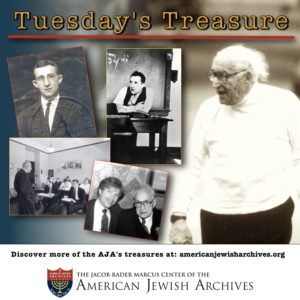Jacob Rader Marcus (1896-1995): the “Dean” of American Jewish historians
Outside the classroom, Marcus became a rabbi and counselor to his students. This, he felt, was part of his rabbinic calling, and he considered it no less important than his scholarship and his teaching. His students reciprocated, electing him president of the Central Conference of American Rabbis in 1949—the first Hebrew Union College professor since Isaac Mayer Wise to be so honored—and lifetime honorary president of the conference in 1978, an honor he esteemed above all the others accorded him. During the final three decades of his life, he looked upon the Reform rabbis of the Central Conference (“his boys,” as he called them, even after the college admitted women) as his own surrogate family. His wife, after years of illness, had died in 1953. His only daughter, Merle (b. 1929), to whom he was deeply attached, perished in a fire in 1965. From that time onward, he confessed in his Moment interview, “the world that means most to me is the rabbinical world.” “When I lost my family, my daughter, the only child I had, people said to me in the funeral sermons, you now have 500 sons. That’s my world.”
In 1938 Marcus published an important textbook, a volume of carefully edited documents dated 315-1791, entitled The Jew in the Medieval World. Here he displayed a singular mastery of primary literature and a prescient interest in usually neglected subjects and sources, such as women’s history, the lives of Jewish laborers, and early American Jewish history. The textbook proved a great success and is still widely used. Continuing to work on neglected subjects, he embarked in the 1930s on an in-depth study of Jewish communal institutions—this at a time when communal institutions of every sort faced daunting challenges.
Throughout the 1930s, Marcus collected source material and urged his students to write papers in the field of American Jewish history; in 1942, celebrated as the 450th anniversary of the discovery of America, he offered what he later described as “the first required graduate course in an academic institution in American Jewish history.” The 1940s saw other scholars, too, strengthen their interest in American Jewish history, including Salo Baron and Oscar Handlin. With the destruction of European Jewry and America’s emergence as the undisputed center of world Jewry, the subject gained new legitimacy, if not urgency. What set Marcus apart was that he knew more than the others did, having come to the field earlier, and he alone decided in the 1940s to devote his full attention to American Jewish history; for him, Europe was now dead.
During the next half-century, Marcus worked systematically to establish American Jewish history as a scholarly discipline. He founded both the American Jewish Archives (1947) and the American Jewish Periodical Center (1956) on the campus of Hebrew Union College (Cincinnati). He served as president and later honorary president of the American Jewish Historical Society. He collected and published thousands of pages of edited primary sources. He created reference tools and a semiannual scholarly journal, American Jewish Archives [Journal] (1948–). He encouraged students and young scholars by answering their questions and helping to fund their research. And he published book after book of his own incomparable scholarship. All of these projects sought to address the lacunae in American Jewish history that he set forth in 1951 when he published his path-breaking two-volume study entitled Early American Jewry. He had single handedly created or inspired practically every one of these “basic tools”called for in the introduction to that book by the time his own life’s work was finished.
Honors were showered upon him in his final years—awards, degrees, testimonials; in 1987 the City of Cincinnati even named the intersection where he lived Jacob Rader Marcus Square. What meant most to him, however, was finishing up his life’s work. He published at least a book a year during his tenth decade, including the four volumes of United States Jewry and a two-volume Concise Dictionary of American Jewish Biography. Two more books were in press at the time of his death: The American Jew, a one-volume narrative history, and The Jew in the American World, a one-volume documentary history. Soon after his death, Brandeis University purchased his library. To help insure that his life’s work continued even after his passing, he left his entire fortune—almost four million dollars—in trust for the American Jewish Archives, renamed the Jacob Rader Marcus Center of the American Jewish Archives in his memory.


